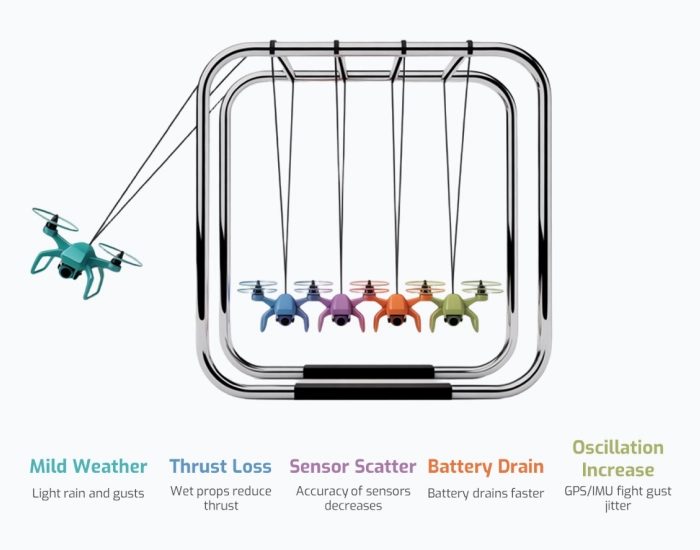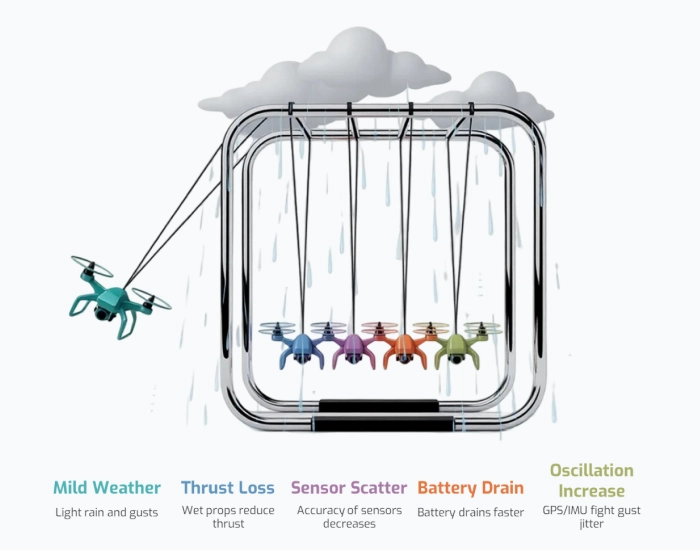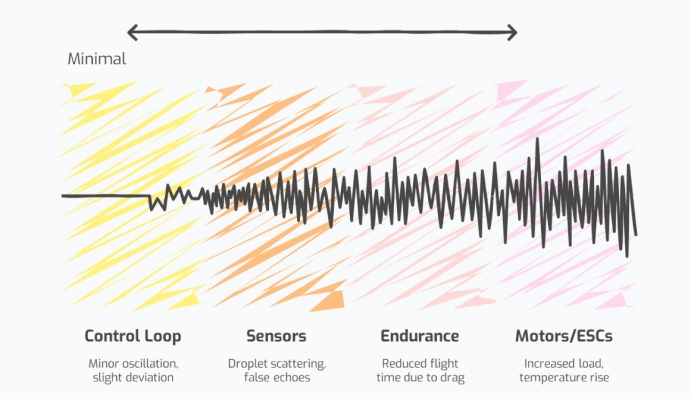The Drizzle That Taught Me More Than a Textbook
It wasn’t a hurricane. A few gusts, just light rain. But thrust struggled, batteries drained early, and stability fluctuated ten minutes into the flight. Of course! When it’s a full blown storm, you stay put, but what about when it’s only mild?
Why Mild Weather Deceives Us?
Light rain and small gusts don’t look dangerous. But for average-sized open frame drones
- Wet props → 5–15% thrust loss (film of water).
- Sensors scatter: lidar/sonar 10–30% accuracy drop.
- Battery drains 10–20% faster to compensate.
- GPS/IMU fight gust jitter, raising oscillations 5–10%.
Ah! Of course, no one wipes the camera’s lens, so forget about visuals.
One Drop, Many Consequences

One Drop, Many Consequences

Rain? An Opportunity, not a Threat
Experimenting will expose issues, not hide them. Flying an open-source quad in drizzle or gusts has real-world challenges. That makes it a strong training and R&D tool.
VIKAS enables easily:
- Adaptivity – swap sensors, retune PIDs, and reconfigure payload logic
- Open Source Power – integrate Pixhawk, Arduino, and custom code with no lock-ins
- Connectivity – talk MAVLink, interface UART, fuse data streams in real-time
The Numbers Are the Lesson
Flights under mild rain and gusts are data-rich lab sessions. What others call fragility, we count as fieldwork.
Here’s what the numbers show us:
- PID struggles under stress: rain adding 5–10% oscillation and gusts adding 30% yaw/pitch deviation
- Noises from water droplets impair lidar/sonar accuracy by 10–30%
- Endurance: Drag + higher current draw cut flight time by 15–25%
- Wet props increase torque demand and motor temperatures by 10-20°C
However, it remains steady below 60 °C
Impact On Components and Systems

When the Basement Almost Became a Rain Lab
Testing drones in mild weather sounds simple… until you try to bring the weather indoors. I even briefly contemplated turning on the office sprinklers and using the VIKAS drone beneath them as a complete “indoor monsoon lab.” Luckily for the janitor, common sense prevailed. Instead of flooding the basement, we reached for a more practical experiment: mist simulation and sensor fusion on the VIKAS drone
Rain‑Ready Sensors: Lidar + Sonar on VIKAS
The VIKAS R&D drone is designed for this type of exploration. Modular frame, dedicated payload and sensor area, straightforward flight controller wiring, and clean power connectors, making it ideal for experiments impossible on a closed commercial drone.
- Lidar (TFMini): Long-range, precise, but rapidly degrades in mist.
- Sonar: A short-range, robust device that works in mild rain.
(Lidar via UART, sonar via digital pins).
I connected each to an Arduino buddy on the VIKAS R&D drone:
- Code fusion: lidar when clean, sonar when wet, or blend (70/30).
- Test: Spray bottle mist, sensor pair facing targets at 1-5 m. Ten-Hz log dry/mist.
Finding:
Droplets reduce Lidar accuracy by 20-40%. Sonar makes noise but stays steady in rain.

Smoother, more dependable fused output: ideal for altitude hold in drizzle.


